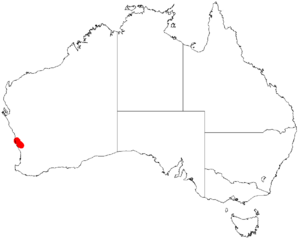Forrest's wattle facts for kids
Quick facts for kids Forrests's wattle |
|
|---|---|
| Conservation status | |
| Scientific classification | |
| Genus: |
Acacia
|
| Species: |
forrestiana
|
 |
|
| Occurrence data from AVH | |
Acacia forrestiana, also known as Forrest's wattle, is a type of shrub. It belongs to the Acacia plant family and is found only in Western Australia. This plant was officially listed as a vulnerable species in 2008. This means it needs special protection to help it survive in the wild.
Contents
What Does Forrest's Wattle Look Like?
This shrub usually grows upright and can be quite open and a bit prickly. It typically reaches a height of about 0.4 to 1.0 meter (which is about 1.3 to 3.3 feet) tall.
Branches and Leaves
Its small branches are covered in fine hairs. They have tiny, stiff leaf-like parts called stipules, which are about 3 to 6 millimeters long. The leaves themselves are called phyllodes. They are green, shaped like a triangle with the wide part at the top, and are packed closely together on the branches. Each phyllode is usually 10 to 20 millimeters long and 5 to 10 millimeters wide.
Flowers and Seeds
Forrest's wattle produces bright yellow flowers. You can usually see these flowers between November and December. Each flower cluster is round and contains about 15 to 20 pale yellow flowers. These clusters grow on a stalk called a peduncle, which is about 9 to 13 millimeters long. After the flowers, flat, oblong seed pods form. These pods are reddish-brown, about 15 millimeters long and 6 millimeters wide, and have lines running along them.
How Forrest's Wattle Got Its Name
This plant was first officially described in 1904 by a botanist named Ernst Georg Pritzel. He worked with another botanist, Ludwig Diels, to study plants in Western Australia. For a short time in 2003, it was given a different scientific name, Racosperma forrestianum, but then it was changed back to Acacia in 2006.
Forrest's wattle is quite similar to another plant called Acacia huegelii, which grows a bit further south. The very first sample of this plant, known as the "type specimen," was collected by Ludwig Diels near a place called Dandaragan in 1901.
Where Does Forrest's Wattle Grow?
Forrest's wattle is found only in a small part of Western Australia. This area is on the west coast, within the Wheatbelt region, between the towns of Coorow and Dandaragan.
Its Habitat
You can find this plant growing on hills, rocky outcrops (called breakaways), and in gullies. It prefers to grow in gravelly clay loam soils, which are often found over laterite (a type of soil rich in iron and aluminum) or sandstone.
Plant Communities
Forrest's wattle often grows as part of a plant community. This can be a heathland (an open area with small shrubs) or a low woodland. In these areas, taller trees like Eucalyptus wandoo and Eucalyptus calophylla might form the upper layer. Below them, you might find other shrubs such as Hakea lissocarpha and different types of Grevillea, Acacia, Isopogon, Calothamnus, and Melaleuca.
Limited Range
This plant has a very limited natural range, covering a distance of about 80 kilometers (about 50 miles). The two main groups of Forrest's wattle plants are found near Dandaragan and Jurien Bay. A large part of its population is protected within Lesueur National Park.


